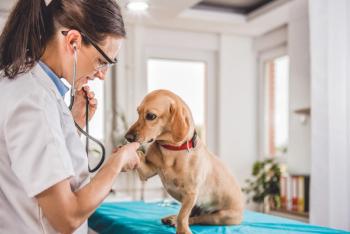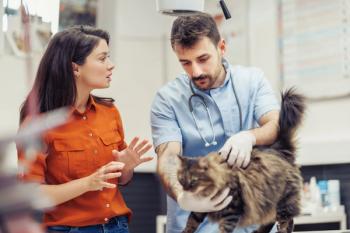
Healthier patients are an annual visit away
My annual visit compliance has skyrocketed to 94% within 18 months of sending out reminder cards.
In 1998 I realized that I wasn't using the annual visit properly. I could foresee the implications of changing vaccine protocols, and I realized I was depriving my patients and my practice by not having a more complete annual visit protocol in place. So I developed a seven-step annual visit to emphasize prevention.1
Dr. Gary D. Norsworthy
The results have profoundly changed my practice. Today, clients better understand that their annual visits are wellness exams, not just vaccination visits. Our patients are healthier because we offer more services, and our practice generates more income because we're offering more of the services pets need.
A program for all practices
I launched my annual wellness program in a canine-feline practice, and I've continued to use it in my feline-only practice. Here is my seven-point plan for an effective wellness exam:
Step 1:Take the patient's history. A receptionist ushers the client into the exam room and asks the client to complete a history form (Figure 1). Key questions help us assess the pet's risks (indoor vs. outdoor pets, boarding pets, and pets that attend cat or dog shows) and signs of disease. We designed the forms so that problematic answers align in the left column. This lets me scan the list quickly and recognize points I need to discuss with the client.
The form also includes space for the client's relevant comments. A bonus: We ask clients whether their contact information has changed in the last year, so we get their most current contact information when we collect the history.
Step 2: Screen with an electrocardiogram (ECG). The technician, with the client's help, records a lead II ECG using a portable ECG machine that is easy to use and offers a quick printout. While the ECG is printing, the technician makes initial entries in the exam-room computer, recording the cat's weight, a list of vaccines needed, diet, current medications, and any issues the client raises.
Step 3: Examine the pet. I perform a thorough examination, beginning with the oral cavity and progressing caudally to the tip of the cat's tail. I speak my findings so the client knows what I see and so the technician can make entries into the objective portion of the problem oriented medical record (SOAP) on my exam-room computer. Because the exam is a critical step in finding early disease, it's important to take a systematic approach so you don't skip body parts.
Figure 1. History Form
Step 4:Perform necessary lab testing. This step depends on the pet's species, age, and whether it lives indoors or outdoors, as well as the client's desires and the practitioner's capabilities. For some cats, we don't perform any tests. For others, especially senior cats, we recommend a blood panel, urinalysis, and blood pressure determination.
Step 5: Offer specific health recommendations. Make your recommendations both verbally and in writing. We use a preprinted annual exam report (Figure 2) or a computer-generated form. Common recommendations include dental cleaning, mass removal, dietary changes, and necessary followup visits to monitor certain conditions. We tape a strip of the lead II ECG to the bottom of this form. Often the client will take the document home to show his or her spouse, other family members, and even other cat owners.
Step 6: Offer general recommendations. Give the client a recommendations handout (Figure 3) with these lists: 1) 12 steps to keep your cat healthy, and 2) 18 early signs of disease. This handout should include instructions to bring the cat in for an exam if the client notices any signs of disease.
Step 7: Give the appropriate vaccinations. The cat receives appropriate vaccinations based on risk assessment. Doing this last sends clients a message that, although vaccinations are important, they aren't the most important part of this visit. My goal is to emphasize healthcare. Having a technician give the vaccines further emphasizes this point, if your state board permits it.
Tips to make it work
Once you've established your program, you'll need to take steps to reinforce your message. For example, I use fees to emphasize the importance of the annual visit. I charge $4 more for an annual exam than for a routine exam. But I charge minimal fees for the vaccines-I only charge $5 for feline rhinotracheitis-caliciviruspanleukopenia vaccination. Ironically, the bottom line cost for the visit is about double what I used to charge when I priced vaccines higher and didn't charge for the exam. Another important point: Giving fewer vaccines doesn't significantly alter the total bill.
Figure 2. Annual Exam Report
Initially, I priced the annual visit the same as my routine exam. I increased the fee after about 18 months. Some clients said they didn't want the exam, they only wanted the vaccines. After checking with my state board, I found that a rabies vaccine could only be administered to a healthy animal, which required an examination by a veterinarian. If clients complained, I agreed to a brief exam, which omitted steps 1, 2, 4, 5, and 6. If they further insisted on no exam, I told them they would need to find another veterinarian. I lost very few clients, and those who left were not missed.
I handle the initial puppy or kitten series a bit differently. I omit steps 1 and 2, and I charge my routine exam fee for the first visit with the same vaccine fees. On the second and third visits, I charge a recheck exam plus vaccines, unless I spend excessive time examining the pet or talking with the client. In this case, I'll charge the higher exam fee.
Everyone wins
We see enormous benefits from our annual wellness program every day. For example, we're now more efficient because a technician precedes me and completes the first two steps before I enter the room. This saves time and allows my practice to care for clients and patients more efficiently. And clients feel better served-several have told me that we give their cats better exams than the clients receive from their own physicians. Our client numbers continue to grow from referrals. And my annual visit compliance has skyrocketed to 94% within 18 months of sending out reminder cards.
Figure 3. Recommendations for cat owners
My practice is literally fueled with findings from annual visits. We perform an average of more than 50 ECGs per week, including those performed during annual visits, on cats with cardiac disease, and for preanesthetic screenings. Because we aggressively evaluate and treat cats for cardiac disease, we also average more than 10 echocardiograms per week. This means additional income from radiographs, laboratory tests, hospitalization, drugs dispensed, and therapeutic diets.
Today, my patients are healthier-and so is my practice. Sure, my current approach isn't the way I practiced for the first 25 years of practice. But it's one of the best changes I've made.
Reference
1.Norsworthy G.D.; Another perspective on the vaccination controversy: Redefining the annual visit.
Vet. Med. 94
(8):736-742; 1998
Dr. Gary D. Norsworthy is a 1972 graduate of Texas A&M University. He practiced for two years at the Cat Clinic of Seattle, Washington. He practiced small-animal medicine from 1974 to 1999 in San Antonio, Texas, and then opened a feline only practice in San Antonio in early 2000. Dr. Norsworthy is also an accomplished author, editor, and lecturer. He has presented more than 300 lectures at veterinary conferences across the country.
Newsletter
From exam room tips to practice management insights, get trusted veterinary news delivered straight to your inbox—subscribe to dvm360.





